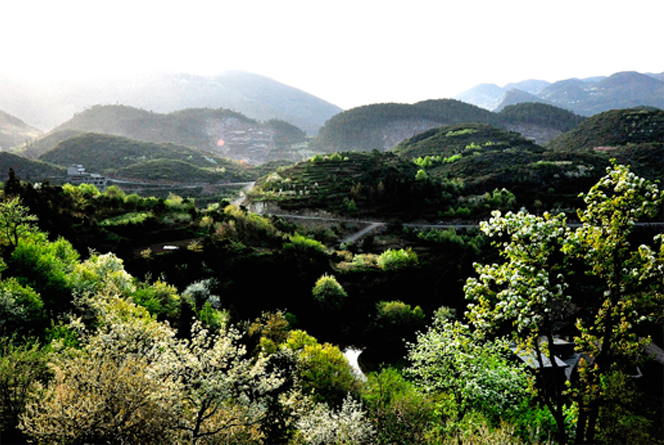- Profile Jurisdictions GOV DEPARTMENTS Cultures Travelling Educate
-
Yinjang Tujia and Miao Autonomous County is located in the northeastern part of Guizhou Province and the western part of Tongren City, situated at the foot of Mount Fanjing, one of China's top ten summer resorts. The county covers a total area of 1,969 square kilometers, with 51,391.38 hectares of arable land. It administers 1 township, 13 towns, and 3 sub-district offices, comprising 357 village committees, 20 community residents' committees, and 3,253 village groups. By the end of 2024, the county's registered population was 442,500. Major mineral deposits include manganese, coal, silicon, magnesium, granite, pyrite, and barite, with a forest coverage rate of 70.4%. It is known as the “Hometown of Famous Chinese Tea,” “Hometown of Chinese Calligraphy,” and “Hometown of Longevity.”

In the third year of the Wude era of the Tang Dynasty (620), Sìwáng County was established within its borders. In the fourth year of the Kaiyuan era of the Tang Dynasty (716), Sìqiōng County was added. In the eighth year of the Zhenghe era of the Northern Song Dynasty (1118), Sìqiōng County was renamed Sìbǎo, and in the third year of the Xuanhe era (1122), Sìwáng County was renamed Lángshuǐ Dòng. Both were subordinate to Sìzhōu during the first year of the Shengxiang era of the Southern Song Dynasty (1131). In the eighth year of the Zhi Yuan era of the Yuan Dynasty (1271), Sibao was renamed Sique Jiang Chieftain's Office, and in the 28th year (1291), Juece Man Yi Chieftain's Office was established. In the fourth year of the Zhi Zheng era (1344), Sique Jiang Chieftain's Office, Juece Man Yi Chieftain's Office, and Langshui Dong were placed under the jurisdiction of Sizhou Xuanwei Office. In the fourth year of the Hongwu era of the Ming Dynasty (1371), the Siquanjiang Chieftaincy, the Juezhe Manchu Chieftaincy, and Langshui Dong were transferred to the jurisdiction of the Sinnan Xuanwei Office. In the tenth year of the Hongwu era (1377), Langshui Dong was reorganized into the Langxi Manchu Chieftaincy. In the eleventh year of the Hongwu era (1378), the Juezhe Manchu Chieftaincy was merged into the Langxi Manchu Chieftaincy. In the 11th year of the Yongle era (1413), the Langxi Barbarian Chieftain's Office was transferred to the jurisdiction of the Wuro Prefecture, and the Siquanjiang Barbarian Chieftain's Office was transferred to the jurisdiction of the Sinnan Prefecture. In the 7th year of the Hongzhi era (1494), the Siquanjiang Barbarian Chieftain's Office was abolished, and Yinjian County was established, under the jurisdiction of the Sinnan Prefecture. In the 10th year of the Daoguang reign of the Qing Dynasty (1830), the Langxi Barbarian Chieftain's Office was merged into Yinjian County. In the 2nd year of the Republic of China (1913), it was under the jurisdiction of the Qiandong Circuit of Guizhou Province; in the 14th year of the Republic of China (1925), the Qiandong Circuit was abolished, and it came under direct provincial administration; From the 24th year of the Republic of China (1935) to 1950, it successively belonged to the Sixth Administrative District of Guizhou Province, the Sixth Administrative Inspection District of Guizhou Province, and the Qiandongnan Military District. In 1950, the Yinjian County People's Government was established, subordinate to the Tongren Administrative Office; in 1986, Yinjian County was abolished, and the Yinjian Tujia and Miao Autonomous County was established based on the original administrative structure. In 1992, it was designated by the State Council as an inland county open to foreign trade; in 1998, it was designated by the Guizhou Provincial Party Committee and Provincial Government as a revolutionary old area; in 2004, it was awarded the title of “National Science Popularization Demonstration County” by the China Association for Science and Technology; in 2008, it was named a “Provincial Civilized County Town” by the Guizhou Provincial Government; in 2010, it was named “China's Famous Tea Hometown” by the Chinese Tea Science Institute and the Tea Society; In December 2011, it was named a “Chinese Folk Cultural and Artistic Homeland • Calligraphy” by the Ministry of Culture of the People's Republic of China and a “Chinese Calligraphy Homeland” by the China Calligraphers Association; in 2012, it was awarded the title of “Chinese Longevity Homeland” by the Chinese Gerontological Society; and in 2016, it was recognized as a “National Agricultural Product Quality and Safety County.”

contact details
Tel:00-86-0856-6222991
Address:Yinjang Autonomous County, Eling Street, County Government Road No. 286 (County Government Building)
Working hours:Monday to Friday, 8:30 AM to 12:00 PM, 2:30 PM to 6:00 PM (excluding public holidays and weekends)
